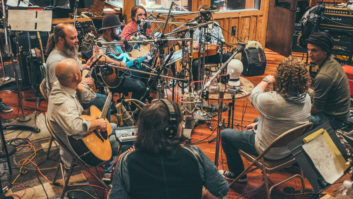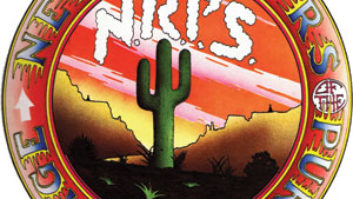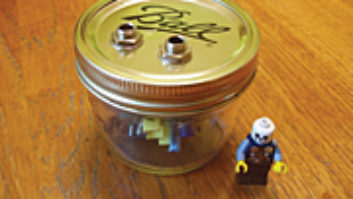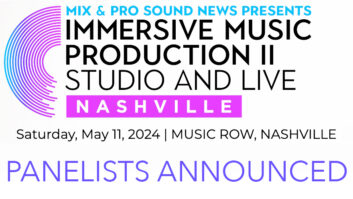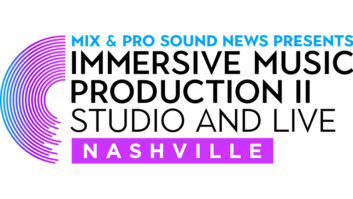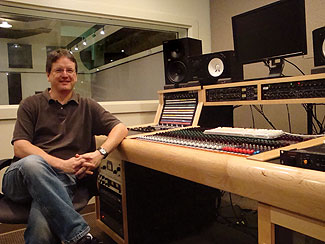
Belmont studio manager Michael Janas at the Toft Audio Designs console
Photo: Peter Cooper
There were a couple of ways to look at the situation.
“Well, I knew it was going to be a challenge,” says acoustician David Rochester, who runs Technical Audio Services and who has been hired by Belmont University to help resurrect Nashville’s famed Quonset Hut. One can view such a project as a chance to shape history. One can also view it as a whale of a task. “Most people don’t build a studio in a half-pipe,” Rochester says. “The eight-second reverb time in the room was probably the biggest part of the challenge.”
For months, the studio where Patsy Cline’s “Crazy” and Brenda Lee’s “I’m Sorry” had been recorded was a cacophonous environment, as carpenters pounded drywall and cringed as each bang of the hammer was echoed and amplified. But in the end, a room that had been closed for studio business since 1982 was resurrected as a working studio and as a classroom for Belmont University’s Mike Curb College of Entertainment and Music Business.
“Part of the students’ experience is understanding the history here,” says Belmont studio manager Michael Janas. “Students approach a sound engineering class differently when they realize they’re standing in a space where Johnny Cash recorded, or that they might be standing on the very spot where Patsy Cline sang ‘Crazy.’”
Built in the 1950s by Owen Bradley and his guitar-playing brother, Harold Bradley, the Quonset Hut became an essential building block for what is now Music Row. The hut was attached to Bradley Film & Recording, and it preceded RCA Studio B, which opened in 1957. The Bradleys sold the building to Columbia Records in 1962, and it remained in heavy use until 1982, when Columbia dismantled the studio and used the space for its art department.
“It was always a half-pipe setup, kind of like half a Coke can stuck on the ground, but it was a great vibe room for the way they recorded at the time,” says Janas, who had worked as studio manager at RCA Studio B and who began overseeing the Quonset Hut’s revitalization in 2007. “We initially planned on trying to re-create 1962, but ultimately we found out that we were better off taking a different route.”
Enormous expense was one barrier to replication: The wood that featured prominently at the original Hut was relatively inexpensive in the 1960s, but not so much in the new century. But Janas, Rochester and others on the project also realized that while the original studio was intended as a place to record music live and without headphones, the new model would need to bolster the experience of students who sought to learn about new-era audio engineering. It would also need to multitask and be appropriate for classroom sessions and meetings.
“I’ve done a lot of projects, but none that prepared me for this,” Rochester says. “I’ve never dealt with a place where all the energy focused back to the center of the room. We had to distribute the sound evenly and not over-dampen it. It needed to still have some life and musicality. And Mike Curb’s request was to leave it so you could tell it was a curved ceiling, and that’s another challenge.
Roughly half of the material used for diffusion was purchased, while the other half was custom-made by Rochester’s team. Among the hand-crafted items are the big polydiffusers on the side walls, made of bendable plywood. Much of the diffusion system was made by Novawall, which produces fabric walls and ceiling systems. The barnwood paneling of the Quonset Hut’s heyday, a backdrop for television shoots, is no longer present.
In the control room, students will learn signal flow via a 24-track Toft Audio Designs console. Curb’s “Audio 1” class moves between the Quonset Hut and RCA Studio B, and Janas wanted the monitoring system to be the same in both studios, so the Hut now features Mackie 824s and Yamaha NS-10 near-field monitors. There is also a supply of classic outboard gear (Teletronix LA-2A compressor, UREI 1178 stereo compressor, etc.) and some not-so-typical gear.
“We have some mic pre’s that we build ourselves here at Belmont,” Janas says. “Our maintenance class builds these 6-channel pre’s with some technology based on API, some based on Sphere and some based on Millennia.”
The Quonset Hut’s microphones and other original gear were sold in the early 1980s to various buyers, but at least one major recording tool remains. “We do have the original reverb chambers here,” Janas says, smiling and pointing to the back wall. “There’s a tech shop right behind the control room, and the chambers are right above the tech shop.”
